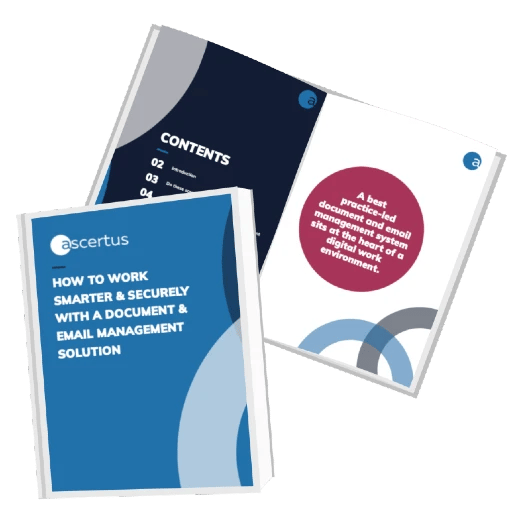

Syncly data sync and archive management
Stop building your own custom integrations. Not only can this tie up valuable resources and cost a considerable amount of money, but it also places the risk on you to ensure data is handled appropriately!
Save at least 1 hour per matter per month, spent manually downloading and uploading documents between systems. Furthermore, remove the stress of having the wrong version of a document shared with your client.
We realise that a growing tech stack brings with it a disproportionate amount of stress with respect to managing aspects of Risk and Compliance regarding how, when and where your data is managed.
Why you should choose Syncly
Fragmented data systems
![]() Many organisations struggle with managing data across multiple platforms, leading to inefficiencies and data silos. Syncly solves this by providing seamless, real-time synchronisation of documents and data across various systems, ensuring that all relevant information is centralised and up-to-date, which improves collaboration and decision-making.
Many organisations struggle with managing data across multiple platforms, leading to inefficiencies and data silos. Syncly solves this by providing seamless, real-time synchronisation of documents and data across various systems, ensuring that all relevant information is centralised and up-to-date, which improves collaboration and decision-making.
Manual workflow management
 Businesses often rely on manual processes for data synchronisation and archiving, which can be time-consuming and error-prone. Syncly offers no-code integration and a user-friendly workflow builder, allowing non-technical users to automate these processes easily, reducing the workload on IT departments and minimising human errors.
Businesses often rely on manual processes for data synchronisation and archiving, which can be time-consuming and error-prone. Syncly offers no-code integration and a user-friendly workflow builder, allowing non-technical users to automate these processes easily, reducing the workload on IT departments and minimising human errors.
Inefficient customer feedback analysis
![]() Analysing customer feedback can be challenging due to the volume of data and the need for timely insights. Syncly's AI-driven platform automates the categorisation and prioritisation of feedback, enabling companies to quickly identify and address critical issues, improving customer satisfaction and preventing churn.
Analysing customer feedback can be challenging due to the volume of data and the need for timely insights. Syncly's AI-driven platform automates the categorisation and prioritisation of feedback, enabling companies to quickly identify and address critical issues, improving customer satisfaction and preventing churn.
Security and compliance concerns
![]() Managing sensitive data across various platforms while ensuring compliance with industry regulations is a significant challenge. Syncly addresses this by offering robust security features, including encryption, Single Sign-On (SSO), and compliance with SOC 2 Type II and GDPR standards, ensuring that data is handled securely and in compliance with regulatory requirements
Managing sensitive data across various platforms while ensuring compliance with industry regulations is a significant challenge. Syncly addresses this by offering robust security features, including encryption, Single Sign-On (SSO), and compliance with SOC 2 Type II and GDPR standards, ensuring that data is handled securely and in compliance with regulatory requirements
Comprehensive data sync features
How to get the most value from Syncly
Real-time data synchronisation
This feature enables seamless, real-time synchronisation of documents and data across different platforms. By integrating various systems into one cohesive network, Syncly eliminates data silos and ensures that all users have access to the most current information, which enhances collaboration and decision-making across the organisation.
No-Code workflow builder
Syncly provides a no-code integration platform that allows users to create and manage data synchronisation workflows without needing any technical expertise. This feature significantly reduces the burden on IT departments by allowing non-technical users to automate processes, which saves time and reduces the risk of human error in manual.
AI-driven customer feedback analysis
Syncly's AI capabilities are designed to automatically categorise, prioritise, and analyse customer feedback. This feature helps businesses quickly identify critical issues and trends, enabling them to respond proactively to customer needs, improve satisfaction, and reduce churn. The platform also provides detailed reports and visualisations to make insights easily understandable for all stakeholders.
Robust security and compliance features
To address security and compliance concerns, Syncly offers enterprise-grade security features such as Single Sign-On (SSO), data encryption, and compliance with standards like SOC 2 Type II and GDPR. These features ensure that sensitive data is handled securely and meets industry regulations, which is crucial for maintaining trust and avoiding legal issues.


Why syncing documents is about more than just time
It is without doubt document syncing in law firms enhances more than just efficiency—it boosts transparency, collaboration, and client trust. By automating processes, it reduces errors, ensures compliance, and improves overall productivity. Syncing also minimises risks, lowers costs, and strengthens client relationships, making it essential for modern legal practices to stay competitive.
Works with
Why legal technology products fail
A legal tech implementation may fail due to poor user adoption, inadequate training, and lack of proper integration. Generally, if a legal technology product isn't user-friendly or well-integrated with other tools, or if its benefits aren't clear, users may resist adopting it and continue using familiar, less efficient methods. In this situation it becomes challenging to achieve ROI, or the implementation can fail altogether.
The Ascertus solution
At Ascertus we work collaboratively with our vendors and clients alike. This means we work in partnership to:
- Establish business needs and objectives
- Review appropriate solutions
- Build an implementation strategy
- Develop a bespoke onboarding program
- Train employees to ensure adoption
- Provide ongoing support and advice

Four steps to start your Syncly journey
Book a meeting
One of expert consultants will discuss any business pain points and objectives.
Product demo
Based on the initial discovery we will tailor a solution on demo the benefits.
Project scope
Align on timings, budget and project structure, to support the Business Case.
Strategy defined
An in-depth implementation strategy is defined to ensure projects success.
Syncly resources

Watch our Syncly demo: Data and usage governance with Syncly
Is syncing the same as data transfer?
Syncing and data transfer differ in that data transfer is a one-time movement of data, while syncing continuously updates and maintains consistency across systems. Syncly stands out by automating real-time synchronisation across multiple platforms, ensuring all data remains current and aligned without manual effort, which is crucial for complex, data-intensive environments like legal firms.
What is the purpose of syncing?
The purpose of syncing is to ensure consistent, real-time data updates across multiple systems, preventing discrepancies and enhancing collaboration. Syncly facilitates this by automating synchronisation, eliminating the need for manual updates, reducing errors, and ensuring all users access the most current information. This is crucial for efficient operations, especially in data-intensive environments like legal and customer-focused industries.
What is an example of data synchronisation?
An example of data synchronisation is updating a client's information in a CRM system, which automatically reflects across related systems like email and billing platforms. Syncly helps by automating this process, ensuring real-time updates across all platforms, reducing manual errors, and improving efficiency, especially in environments where accurate and timely data is critical.
What Syncly clients have to say
We don't expect you just to take our word for it. Syncly clients span a wide range of industries and sectors, in lots of different countries.

By leveraging the intuitive Sync and Archive capabilities, Syncly has allowed us to avoid data silos, provide clients with real-time access to their data, and better manage costs.
Roberto Dettori, I.T. Manager
CARDANO

Syncly makes moving documents across our tech stack a simple, secure, and intuitive process.
Michelle Grossmann, Chief Innovation Officer
Lander & Rogers

With Syncly, we enable the movement of documents from our DMS to HighQ. We then automate the archival of data upon matter closure.
Asitha Udumalagala, Head of Information Technology
Makinson d'Apice

Want to learn how to work smarter and more securely?
Download our FREE eBook today to see how a centralised repository for matter-related information can help.
.png?width=180&height=65&name=Ascertus%20Logo_360x130%20(1).png)
